Nestled in the eastern Himalayas, Sikkim is a land of snow-capped peaks, verdant valleys, crystal-clear rivers, and rich cultural heritage. Known for its pristine landscapes and touruism, this small but captivating Indian state is one of the country’s most sought-after travel destinations. Sikkim provides an unforgettable Himalayan experience, whether you’re a nature enthusiast, adventure lover, or cultural explorer.
While Ladakh Tourism draws travelers to the rugged high-altitude desert of the north, Sikkim Tourism captures hearts with its lush greenery, mystical monasteries, and breathtaking Himalayan panoramas. This contrast makes both destinations unique jewels in India’s tourism crown.
Getting to Sikkim
Gangtok, the capital city, serves as the primary entry point to Sikkim. The nearest airport is Pakyong Airport, about 35 km from Gangtok, though many travelers also fly into Bagdogra Airport in West Bengal, followed by a scenic 4-5 hour drive.
The closest railway station is New Jalpaiguri (NJP), offering connections to major Indian cities. From there, shared jeeps, taxis, and buses offer connections into Sikkim.
Best Time to Visit
Sikkim can be visited throughout the year, but the best time to go depends on the experience you’re seeking:
- Spring (March–May) – Rhododendrons bloom, valleys turn vibrant, and skies remain clear.
- Summer (June–August) – Lush greenery after light showers, ideal for monsoon lovers.
- Autumn (September–November) – Crisp weather, snow-kissed peaks, and excellent visibility.
- Winter (December–February) – Snow in higher altitudes, making it magical for winter tourism.
Just like Ladakh Tourism thrives in summer for its high-altitude passes, Sikkim offers seasonal diversity that appeals to travelers year-round.
Top Tourist Attractions in Sikkim
1. Gangtok – The Heart of Sikkim
Perched at 5,410 ft, Gangtok blends modern urban charm with Buddhist traditions. Visit MG Marg for shopping and cafés, explore the Namgyal Institute of Tibetology, and enjoy panoramic views from Tashi Viewpoint.
2. Tsomgo Lake
Located 40 km from Gangtok, this glacial lake changes colors with the seasons. In winter, it freezes entirely, while in spring, the surrounding slopes burst into bloom.
3. Nathula Pass
Part of the historic Silk Route, Nathula Pass connects India with China. Open to Indian nationals (with a permit), it offers thrilling high-altitude views.
4. Yumthang Valley – Valley of Flowers
Famed for its rhododendron blooms and hot springs, Yumthang is a paradise for nature lovers.
5. Pelling and Kanchenjunga Views
Pelling is known for unobstructed views of Mount Kanchenjunga, the third-highest mountain in the world. The Pemayangtse Monastery nearby is among the oldest in Sikkim.
6. Ravangla and Buddha Park
A serene town with panoramic Himalayan vistas and the grand Tathagata Tsal (Buddha Park), offering peace and meditation.
7. Goechala Trek
For trekking lovers, Goechala provides a close-up view of Kanchenjunga and ranks among the most scenic trails in India.
Adventure Activities in Sikkim
Sikkim is a playground for adventure lovers:
- Trekking – Goechala, Dzongri, and Green Lake treks offer stunning views.
- River Rafting – The Teesta River is perfect for white-water rafting.
- Paragliding – Fly over Gangtok’s valleys and enjoy Himalayan panoramas.
- Mountain Biking – Ride through winding mountain trails.
While Ladakh Tourism is famous for high-altitude motorbiking, Sikkim’s adventure tourism thrives on trekking, rafting, and eco-friendly travel.
Cultural Experiences
Sikkim’s cultural landscape is shaped by its three main ethnic communities – Lepchas, Bhutias, and Nepalis. Festivals like Losar (Tibetan New Year), Saga Dawa, and Pang Lhabsol showcase vibrant traditions, mask dances, and Buddhist rituals.
Cuisine to Try
Sikkim’s food is a delicious blend of Tibetan, Nepali, and local flavors. Don’t miss:
- Momos – Steamed or fried dumplings with meat or vegetable filling.
- Thukpa – Warm noodle soup perfect for chilly evenings.
- Phagshapa – Pork stew with radishes and chili.
- Gundruk – Fermented leafy greens.
Pair these with local teas for a wholesome Himalayan dining experience.
Travel Tips for Sikkim Tourism
- Permits – Protected areas like Nathula Pass, Tsomgo Lake, and North Sikkim require special permits, which can be arranged through tour operators.
- Altitude – While Sikkim’s lower regions are comfortable, higher areas like Gurudongmar Lake are above 17,000 ft and may cause altitude sickness.
- Eco-friendly Travel – Plastic bags are banned; carry reusable bottles and bags.
- Local Etiquette – Dress modestly in monasteries, remove shoes before entering, and avoid touching sacred objects.
Comparing Sikkim Tourism with Ladakh Tourism
Both Sikkim and Ladakh are Himalayan marvels, yet they offer contrasting landscapes and travel experiences:
- Sikkim Tourism – Lush valleys, alpine forests, flower-filled meadows, and snow-capped peaks. Best for cultural immersion, nature walks, and moderate treks.
- Ladakh Tourism – Stark mountains, cold deserts, turquoise lakes, and Buddhist monasteries. Ideal for high-altitude biking, challenging treks, and adventure expeditions.
Travelers seeking a softer, greener Himalayan escape often choose Sikkim, while those craving a rugged, high-altitude challenge gravitate towards Ladakh.
Suggested Itinerary for Sikkim Tourism
Day 1–2: Arrive in Gangtok and visit MG Marg, Tashi Viewpoint, and Rumtek Monastery.
Day 3: Visit Tsomgo Lake and Nathula Pass.
Day 4–5: Head to North Sikkim – Yumthang Valley and Lachung.
Day 6–7: Explore Pelling, Kanchenjunga Falls, and the Pemayangtse Monastery.
Day 8: Departure.
This itinerary can be extended with treks or combined with Darjeeling for a longer Himalayan journey.
Conclusion
Sikkim Tourism presents a harmonious mix of nature, culture, and adventure. From the majestic peaks of Kanchenjunga to its serene monasteries, every part of Sikkim exudes beauty and tranquility.
Whether you’re walking through rhododendron valleys, sipping tea in Gangtok, or trekking to high mountain passes, this Himalayan paradise will leave an indelible mark on your soul.
And if your heart still yearns for more Himalayan magic, you can always pair your trip with Ladakh Tourism for a contrasting yet equally awe-inspiring adventure in India’s majestic mountains.

